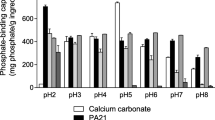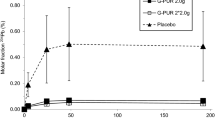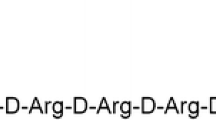Abstract
The efficacy of a chelating agent in binding a given metal in a biological system depends on the binding constants of the chelator for the particular metals in the system, the concentration of the metals, and the presence and concentrations of other ligands competing for the metals in question. In this study, we make a comparison of the in vitro binding constants for the chelator, ethylenediaminetetraacetic acid, with the quantitative urinary excretion of the metals measured before and after EDTA infusion in 16 patients. There were significant increases in lead, zinc, cadmium, and calcium, and these increases roughly corresponded to the expected relative increases predicted by the EDTA-metal-binding constants as measured in vitro. There were no significant increases in urinary cobalt, chromium, or copper as a result of EDTA infusion. The actual increase in cobalt could be entirely attributed to the cobalt content of the cyanocobalamin that was added to the infusion. Although copper did increase in the post-EDTA specimens, the increase was not statistically significant. In the case of magnesium, there was a net retention of approximately 85% following chelation. These data demonstrate that EDTA chelation therapy results in significantly increased urinary losses of lead, zinc, cadmium, and calcium following EDTA chelation therapy. There were no significant changes in cobalt, chromium, or copper and a retention of magnesium. These effects are likely to have significant effects on nutrient concentrations and interactions and partially explain the clinical improvements seen in patients undergoing EDTA chelation therapy.
Similar content being viewed by others
References
E. M. Cranton, X. L. Zheng, and I. M. Smith, Urinary trace and toxic elements and minerals in untimed urine specimens relative to urine creatinine, J. Adv. Med. 1, 331–397 (1989).
M. Hambidge, Human zinc deficiency, J. Nutr. 130(5S Suppl.), 1344S-1349S (2000).
D. A. Skoog and D. M. West, Volumetric methods based on complex-formation reactions, in Fundamentals of Analytical Chemistry, Holt, Rhinehart and Winston, New York, pp. 338–360 (1969).
B. W. Halstead, The Scientific Basis of EDTA Chelation Therapy, TRC, Lanham, SC (1997).
T. C. Rorzema The protocol for the safe and effective administration of EDTA and other chelating agents for vascular disease, degenerative disease and metal toxicity, J. Adv. Med. 10, 11–17 (1997).
H. Foreman and T. Trujillo, Metabolism of carbon 14 labeled ethylenediaminetetraacetic acid in human beings, J. Lab. Clin. Med. 43, 566 (1954).
R. A. Anderson, M. M. Polansky, N. A. Bryden, E. E. Roginski, K. Y. Patterson, and D. C. Reamer, Effect of exercise (running) on serum glucose, insulin, glucagon and chromium excretion, Diabetes 31, 212–216 (1982).
D. W. Cockcraft and M. H. Gault, Prediction of creatinine clearance from serum creatinine, Nephron 16, 31–41 (1976).
J. P. Prackelton, Monitoring renal function during EDTA chelation therapy, J. Holistic Med. 2, 327–330 (1989).
L. M. Klevay, Ischemic heart disease: toward a unified theory, in Role of Copper in Lipid Metabolism, K. Y. Lei, ed., CRC, Boca Raton, FL, pp. 233–267 (1990).
H. D. Riordan, E. Cheraskin, and M. Dirks, Mineral excretion associated with EDTA chelation therapy, J. Adv. Med. 3, 111–123 (1990).
J. P. Frackelton, Monitoring renal function during EDTA Chelation therapy. J. Holistic Med. 8, 33–35 (1986).
C. A. Burtis and E. R. Ashwood, eds., Tietz Textbook of Clinical Chemistry. Trace Elements, W. B. Saunders, Philadelphia, p. 490 (1999).
R. A. Anderson, N. A. Bryden, and R. S. Waters, EDTA chelation therapy does not selectively increase chromium losses, Biol. Trace Element Res. 70, 265–272 (1999).
R. A. Anderson, N. Cheng, N. A. Bryden, M. M. Polansky, N. Cheng, J. Chi, et al., Elevated intakes of supplemental chromium improve glucose and insulin variables in individuals with type 2 diabetes, Diabetes 46, 1786–1791 (1997).
R. A. Anderson, Chromium, glucose intolerance and diabetes. J. Am. Coll. Nutr. 17, 548–555 (1998).
A. Raviva, L. Stezak, N. Mirsky, N. A. Bryden, and R. A. Anderson, Reversal of corticosteroid-induced diabetes mellitus with supplemental chromium, Diabetic Med. 16, 164–167 (1999).
R. A. Anderson, Chromium and diabetes, Nutrition 15, 720–721 (1999).
R. A. Anderson, A. M. Roussel, and J. Neve, Essential trace elements, chromium, copper, iron, zinc and selenium, and cardiovascular diseases, Handbook of Hypertension, Vol. 20, C. J. Bulbitt, ed., Elsevier, New York, pp. 314–335 (2000).
M. Rubin, Enhancement of lead excretion in humans by disodium calcium ethylenedi-aminetetraacetic acid, Science 117, 659–660 (1953).
H. A. Schroeder and H. M. Perry, Antihypertensive effects of metal binding agents, J. Lab. Clin. Med. 46, 416–421 (1955).
H. A. Schroeder and J. Buckman, Cadmium hypertension, its reversal by a zinc chelate, Arch. Environ. Health 14, 693–697 (1967).
D. Krumhout, Blood lead and coronary heart disease among elderly men in Zutphen, the Netherlands, Environ. Health Perspect. 78, 43–46 (1988).
E. W. McDonagh, C. J. Rudolph, and E. Cheraskin, The effects of intravenous disodium EDTA on blood cholesterol in a private practice environment, J. Int. Acad. Prev. Med. 7, 5–12 (1982).
K. W. Sehnert, A. F. Clague, and E. Cheraskin, The Improvement in renal function following EDTA chelation and multivitamin-trace mineral therapy: a study in creatinine clearance, Med. Hypothesis 15, 301–304 (1984).
E. W. Olszewer and J. P. Canter, EDTA chelation therapy: a retrospective study of 2,870 patients, J. Adv. Med. 2, 197–233 (1989).
Food and Nutrition Board, National Research Council: Recommended Dietary Allowances, 10th ed., National Academy of Science, Washington, DC (1989).
C. A. Burtis and E. R. Ashwood, eds., Tietz Textbook of Clinical Chemistry. Trace Elements, W. B. Saunders, Philadelphia, p. 1038 (1999).
S. M. Pilch and F. R. Senti, Analysis of zinc data from the second National Health and Nutrition Examination Survey (NHANES II), J. Nutr. 115, 1393–1397 (1985).
R. R. Briefel, K. Bialostosky, J. Kennedy-Stephenson, M. A. McDowell, R. B. Ervin, and J. D. Wright, Zinc intake of the U.S. population: findings from the third National Health and Nutrition Examination Survey, 1988–1994, J. Nutr. 130(5S Suppl.), 1367S-1373S (2000).
R. A. Jacob, J. M. Munoz, H. H. Sandstead, et al., Whole body surface loss of trace metals in normal males, Am. J. Clin. Nutr. 34, 1379–1383 (1981).
M. H. Stipanuk, Biochemical and Physiological Aspects of Human Nutrition, W.B. Saunders, Philadelphia, p. 750 (2000).
C. A. Burtis and E. R. Ashwood, eds., Tietz Textbook of Clinical Chemistry. Trace Elements, W. B. Saunders, Philadelphia, p. 1396 (1999).
A. G. Goodman and L. S. Gilman, The Pharmaceutical Basis of Therapeutics, 3rd ed., MacMillan, New York, p. 1620 (1985).
L. E. Meltzer, J. R. Kitchell, and F. Palmon, The long term use, side effects and toxicity of disodium EDTA, Am. J. Med. Sci., 242, 11–17 (1961).
M. D. Reuber and J. E. Bradley, Acute versenate nephrosis, JAMA 174, 263–269 (1960).
N. E. Clarke, N. C. Clarke, and R. E. Moshen, Treatment of angina pectoris with disodium EDTA, Am. J. Med. Sci. 232, 654–666 (1956).
C. P. Lamar, Chelation endarterectomy for occlusive atherosclerosis, J. Am. Geriatr. Soc. 14, 272–294 (1966).
E. W. McDonagh, C. J. Ruddolph, and E. Chesarkin, The “clinical change” in patients treated with EDTA chelation plus multivitamin trace mineral supplementation, J. Orthomol. Psychiatry 14, 61–65 (1985).
H. R. Casdorph, EDTA chelation therapy: efficacy in heart disease, J. Adv. Med. 2, 121–129 (1989).
H. R. Casdorph and C. H. Farr, EDTA chelation therapy: treatment of peripheral arterial occlusion, an alternative to amputation, J. Adv. Med. 2, 167–182 (1989).
C. Hancke and K. Flytlie, Benefits of EDTA chelation therapy in atherosclerosis: a retrospective study of 470 patients. J. Adv. Med. 6, 161–171 (1993).
L. T. Chappell and J. P. Stahl, The correlation between EDTA chelation therapy and improvement in cardiovascular function: a meta-analysis. J. Adv. Med. 6, 139–160 (1993).
H. J. Holliday, Carotid restenosis: a case for EDTA chelation, J. Adv. Med. 9, 95–99 (1996).
C. J. Rudolph and E. W. McDonagh, Renal artery stenosis reversal in a hypertensive individual, using a combination of EDTA chelation and multiple vitamin and trace mineral therapy, J. Adv. Med. 12, 193–200 (1999).
N. E. Clarke, C. N. Clarke, and R. E. Mosher, The “in vivo” dissolution of metastatic calcium: an approach to atherosclerosis, Am. J. Med. Sci. 229, 142–146 (1955).
H. A. Schroeder, A practical method for the reduction of plasma cholesterol in man, J. Chronic Dis. 4, 461–465 (1956).
A. Suvorov and R. A. Markosyan, Some mechanisms of EDTA on platelet aggregation, All Union Cardiol. Res. Cend. Moscow, Russia. Byall Eks Biol. Med. 5, 587 (1981).
D. P. Deucher, EDTA chelation therapy: an antioxidant strategy, J. Adv. Med. 1, 182–186 (1988).
B. M. Altura and B. T. Altura, Interactions of Mg and K on blood vessels: aspects in view of hypertension, Magnesium 3, 175–194 (1984).
L. M. Resnick, R. K. Gupta, and J. H. Laragh, Intracellular free magnesium in erythrocytes of essential hypertension: relation to blood pressure and serum divalent cations, Proc. Natl. Acad. Sci. USA 81, 6511–6515 (1984).
K. Kisters, M. Tepel, C. Spieker, K. H. Dietl, M. Barenbrock, K. H. Rahn, et al., Decreased cellular Mg2+ concentrations in a subgroup of hypertensives—cell models for the pathogenesis of primary hypertension, J. Hum. Hypertens. 11, 367–372 (1997).
I. DeLeeuw, W. Engelen, J. Vertommen, and L. Nonneman, Effect of intensive i.v. and oral magnesium supplementation on circulating ion levels, lipid parameters and metabolic control in Mg-depleted insulin-dependent diabetic patients (IDDM), Magnesium Res. 10, 135–141 (1997).
L. Hansson, A. Zanchetti, S. G. Carruthers, B. Dahlof, D. Elmfeldt, S. Julius, et al., Effects of intensive blood-pressure lowering and low-dose aspirin in patients with hypertension: principal results of the Hypertension Optimal Treatment (HOT) randomised trial. HOT Study Group, Lancet 351, 1755–1762 (1998).
J. R. Sowers and B. Draznin, Insulin, cation metabolism and insulin resistance, J. Basic Clin. Physiol. Pharmacol. 9, 223–233 (1998).
H. W. DeValk, Magnesium in diabetes mellitus, Netherland J. Med. 57, 139–146 (1999).
M. Worwag, H. G. Classen, and E. Schumacher, Prevalence of magnesium and zinc deficiencies in nursing home residents in Germany, Magnesium Res. 12, 181–189 (1999).
K. Kisters, Magnesium deficiency and increased fractional magnesium excretion in insulin-dependent diabetes mellitus-magnesium loading fraction and blood pressure, Trace Element Electrolytes 17, 67–70 (2000).
K. L. Woods, S. Fletcher, C. Roffe, et al., Intravenous magnesium sulphate in suspected acute myocardial infarction of the second Leicester Intravenous Magnesium Intervention Trial. (LIMIT-2), Lancet 339, 1553–1558 (1992).
S. M. Horner, Efficacy of intravenous magnesium in acute myocardial infarction in reducing arrhythmias and mortality. Meta-analysis of magnesium in acute myocardial infarction, Circulation 86, 774–779 (1992).
M. A. Brodsky, M. V. Orlov, E. V. Capparelli, B. J. Allen, L. T. Iseri, M. Ginkel, et al., Magnesium therapy in new-onset atrial fibrillation, Am. J. Cardiol. 15, 1227–1229 (1994).
M. Shechter, H. Hod, E. Kaplinsky, and B. Rabinowitz, The rationale of magnesium as alternative therapy for patients with acute myocardial infarction without thrombolytic therapy, Am. Heart J. 132, 483–486 (1996).
G. M. Reaven, Role of insulin resistance in human disease, Diabetes 37, 1595–1607 (1988).
M. Chevion, The use of both “push and pull” mechanisms against free radical induced biological damage, Plzen. Lek. Shorn. 68(Suppl.), 77–81 (1993).
T. M. Bray and W. J. Bettger, The physiological role of zinc an antioxidant, Free Radical Biol. Med. 8, 281–291 (1990).
C. F. Peng, J. J. Kane, M. L. Murphy, and K. D. Straub, Abnormal mitochondrial oxidative phosphorylation of ischemic myocardium reversed by Ca2+-chelating agents. J. Mol. Cell Cardiol. 9, 897–908 (1977).
Author information
Authors and Affiliations
Rights and permissions
About this article
Cite this article
Waters, R.S., Bryden, N.A., Patterson, K.Y. et al. EDTA chelation effects on urinary losses of cadmium, calcium, chromium, cobalt, copper, lead, magnesium, and zinc. Biol Trace Elem Res 83, 207–221 (2001). https://doi.org/10.1385/BTER:83:3:207
Received:
Accepted:
Issue Date:
DOI: https://doi.org/10.1385/BTER:83:3:207




